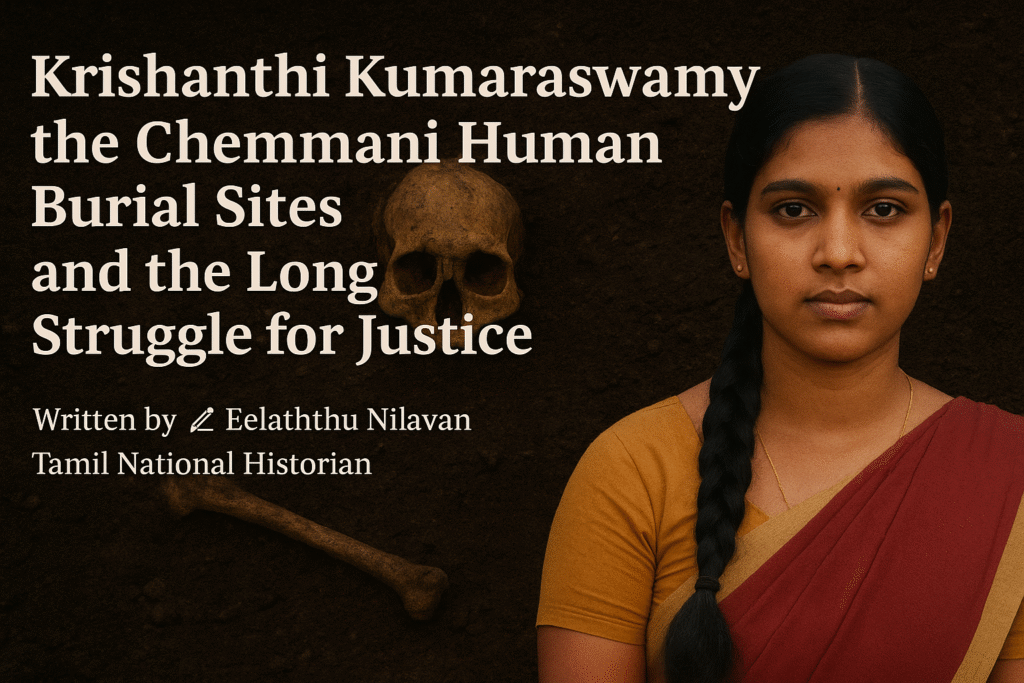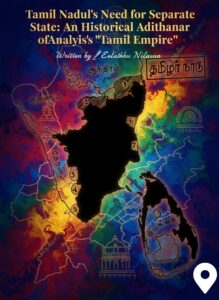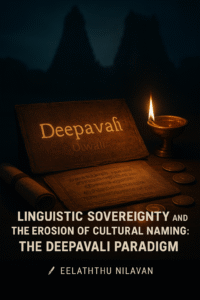Krishanthi Kumaraswamy, the Chemmani Human Burial Sites, and the Long Struggle for Justice
✧.Introduction
On 7 September 1996, 18-year-old schoolgirl Krishanthi Kumaraswamy from Jaffna was brutally gang-raped and murdered by Sri Lankan Army soldiers at a military checkpoint. When her mother, Rassammah, brother Pranavan, and neighbor Kirupakaran (Kirupa) went searching for her, they too were abducted and killed.
Their bodies were later discovered buried in Chemmani, in shallow pits that have since become infamous as some of the most horrific symbols of state-sanctioned violence against Tamils.

Even today, almost three decades later, skeletal remains continue to be unearthed from Chemmani. These discoveries not only reaffirm the truth of Krishanthi’s tragic case but also point toward the existence of hundreds of other victims buried in hidden human burial sites, exposing the scale of wartime atrocities.
✦. The Web of Violence Revealed
The crime and its aftermath:
Krishanthi had just completed her A/L chemistry exam and was returning home when she was stopped at the Kaithady Army checkpoint. She never made it back. Concerned, her mother, brother, and family friend went in search of her. All four were killed.
Convictions and a shocking testimony:
In July 1998, six Sri Lankan soldiers (including Lance Corporal Somaratne Rajapakse) were sentenced to death for the rape and murder of Krishanthi, her mother, brother, and neighbor. During his trial, Rajapakse made a chilling confession—claiming that “300 to 400 bodies” of others who had been tortured and killed were buried at Chemmani. This testimony opened the door to investigations into human burial sites in the area.
✦. From Denial to Revelation: Excavations at Chemmani
The 1999 excavations:
Acting on Rajapakse’s revelations, investigators located 15 skeletons. Some were identified as individuals who had gone missing in 1996. Several remains were found with their hands bound and eyes blindfolded, confirming they had been executed. However, the investigation soon stalled due to political interference.
The 2025 excavations:
In early 2025, construction work in the Chemmani-Sindupathi burial grounds exposed human bones, leading to renewed court-ordered excavations.
︎Initial excavations uncovered 19 skeletons, including three children, as well as personal items such as a schoolbag.
︎By August 2025, the number had risen to 141 skeletons, including children. Baby bottles, toys, clothing, and other belongings were also discovered—grim evidence that ordinary civilians, including children, were among those buried in these human burial sites.
The role of the Human Rights Commission:
In August 2025, the Human Rights Commission of Sri Lanka (HRCSL) visited Chemmani and declared that the remains likely represented extrajudicial killings. It called for international forensic expertise to ensure credible investigations.
Calls from international law experts:
The International Commission of Jurists (ICJ) emphasized that all investigations must follow the Minnesota Protocol on the investigation of unlawful deaths and urged Sri Lanka to allow independent international oversight.
✦. Political Inaction and the Absence of Justice
Government negligence:
Despite the gravity of these revelations, successive Sri Lankan governments have shown little willingness to pursue justice. Institutions like the Office on Missing Persons (OMP) were created but quickly lost public trust due to political interference.
Suppressing the truth:
Rajapakse later claimed he faced political pressure not to reveal more human burial sites, and that he was assaulted in prison for refusing to retract his statements. His lawyer, prominent Tamil rights advocate Kumar Ponnambalam, was assassinated—further silencing avenues for truth.
Human burial sites as a national disgrace:
Chemmani is not an isolated case. Similar human burial sites have been discovered in Mannar, Sooriyakanda, Matale, and even at the Duraiappah Stadium in Jaffna. Hundreds of skeletons have been exhumed across these sites, but most investigations remain stalled or compromised by political pressure.
✦. The Path Forward
︎ Truth as healing: The Chemmani excavations, while deeply painful, provide acknowledgment for families of the disappeared. Recognition of their suffering is the first step toward reconciliation.
︎ Ensuring credible investigations: If proper forensic standards are not followed, evidence risks being destroyed or manipulated, burying the truth once more.
︎ The necessity of international involvement: Given the repeated failures of domestic mechanisms, international monitoring and forensic expertise are essential to safeguard transparency and impartiality.
︎ Sri Lanka’s international obligations: Under treaties such as the ICCPR and the ICPPED, Sri Lanka is obligated to protect the right to life, investigate disappearances, and provide justice. Meeting these obligations would turn Chemmani from a symbol of injustice into a foundation for accountability.
✦. Conclusion:
The tragic death of Krishanthi Kumaraswamy remains an unhealed wound in Tamil history. Her brutal murder—and the murders of her family—exposed the horrors of Sri Lanka’s wartime atrocities to the world.
Today, the earth of Chemmani continues to yield bones and belongings of the disappeared, standing as evidence of hidden killings buried in human burial sites.
Only when the Sri Lankan state allows independent, transparent, and internationally monitored investigations will Chemmani transform from a symbol of injustice into a cornerstone of truth and accountability—paving the way toward reconciliation and lasting peace.

Written by Eelaththu Nilavan
Tamil National Historian – Analyst of Global Politics, Economy, and Military Affairs
07/09/2025


